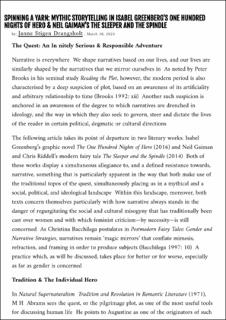| dc.description.abstract | Narrative is everywhere. We shape narratives based on our lives, and our lives are similarly shaped by the narratives that we mirror ourselves in. As noted by Peter Brooks in his seminal study Reading the Plot, however, the modern period is also characterised by a deep suspicion of plot, based on an awareness of its artificiality and arbitrary relationship to time (Brooks 1992: xii). Another such suspicion is anchored in an awareness of the degree to which narratives are drenched in ideology, and the way in which they also seek to govern, steer and dictate the lives of the reader in certain political, dogmatic or cultural directions.
The following article takes its point of departure in two literary works: Isabel Greenberg’s graphic novel The One Hundred Nights of Hero (2016) and Neil Gaiman and Chris Riddell’s modern fairy tale The Sleeper and the Spindle (2014). Both of these works display a simultaneous allegiance to, and a defined resistance towards, narrative, something that is particularly apparent in the way that both make use of the traditional topos of the quest, simultaneously placing us in a mythical and a social, political, and ideological landscape. Within this landscape, moreover, both texts concern themselves particularly with how narrative always stands in the danger of regurgitating the social and cultural misogyny that has traditionally been cast over women and with which feminist criticism—by necessity—is still concerned. As Christina Bacchilega postulates in Postmodern Fairy Tales: Gender and Narrative Strategies, narratives remain ‘magic mirrors’ that conflate mimesis, refraction, and framing in order to produce subjects (Bacchilega 1997: 10). A practice which, as will be discussed, takes place for better or for worse, especially as far as gender is concerned. | en_US |
